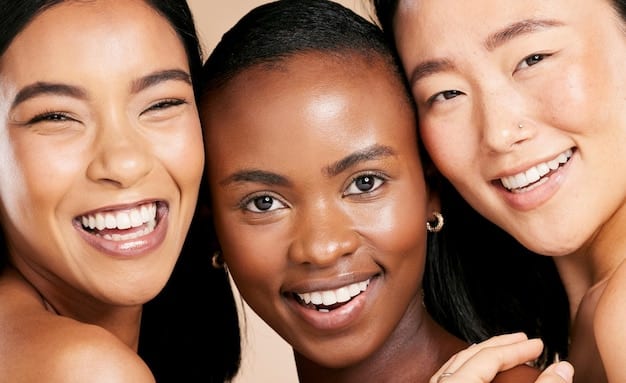The Latest Skincare Trends of 2025: Are They Worth the Hype?

The latest skincare trends of 2025 highlight a shift towards personalized beauty, incorporating AI-driven diagnostics, microbiome-friendly products, and sustainable packaging, but their long-term effectiveness and accessibility remain key considerations.
Are you ready to dive into the future of skincare? The latest skincare trends of 2025: What’s Worth the Hype? is the question on everyone’s lips, and we’re here to unpack it all.
Decoding the 2025 Skincare Landscape
The skincare industry is constantly evolving, and 2025 promises to bring a wave of new products, technologies, and approaches. From AI-powered personalized routines to sustainable and microbiome-friendly solutions, the options can seem overwhelming. Let’s explore the key trends shaping the future of skincare and separate the genuine innovations from the fleeting fads.
Understanding these trends allows you to make informed decisions about your skincare routine and choose products and practices that align with your individual needs and values. It’s not just about following the hype; it’s about finding what truly works for you.
Personalized Skincare Powered by AI
One of the most significant trends is the rise of personalized skincare solutions driven by artificial intelligence. AI-powered tools analyze your skin’s unique characteristics and recommend customized product formulations and routines.
- Advanced Skin Analysis: AI algorithms can analyze skin texture, hydration levels, and even detect underlying issues like potential breakouts or sun damage.
- Custom Formulations: Based on the analysis, companies are creating personalized serums, moisturizers, and cleansers tailored to individual needs.
- Smart Devices: Devices like smart mirrors and handheld skin scanners provide real-time feedback and track progress over time.
This level of personalization promises to deliver more effective results compared to generic skincare products. However, it’s crucial to ensure the accuracy and reliability of the AI-powered tools and the transparency of the data being collected.
The Rise of Microbiome Skincare
The skin microbiome, the community of microorganisms living on our skin, is gaining increasing attention in the skincare world. Products that support a healthy microbiome are expected to become even more prevalent in 2025.
Maintaining a balanced skin microbiome is essential for skin health, as these microorganisms play a crucial role in protecting against pathogens, regulating inflammation, and supporting the skin’s barrier function. Let’s explore this trend further.

Prebiotics, Probiotics, and Postbiotics
Microbiome skincare focuses on nourishing and balancing the skin’s natural flora using prebiotics, probiotics, and postbiotics.
- Prebiotics: These ingredients provide food for beneficial bacteria, helping them thrive and outcompete harmful microorganisms.
- Probiotics: Live microorganisms that can replenish the skin’s microbiome and improve its overall health.
- Postbiotics: By-products of probiotic fermentation that offer benefits such as anti-inflammatory and antioxidant properties.
By incorporating these ingredients into skincare formulations, brands aim to strengthen the skin’s natural defenses and promote a healthy, resilient complexion. It is important to research the efficacy of these ingredients.
Sustainable and Ethical Skincare Practices
Consumers are increasingly conscious of the environmental and social impact of their skincare choices. This demand for sustainable and ethical practices is driving significant changes in the industry.
In 2025, expect to see even greater emphasis on eco-friendly packaging, responsibly sourced ingredients, and cruelty-free testing. Companies that prioritize sustainability will likely gain a competitive edge. Let’s break down the key areas of focus.
Eco-Friendly Packaging Innovations
Traditional skincare packaging often relies on single-use plastics, contributing to environmental pollution. Brands are exploring innovative alternatives to reduce their packaging footprint.
Some current trends are:
- Refillable Systems: Products are sold with reusable containers, and refills are purchased in minimal packaging.
- Biodegradable Materials: Packaging made from plant-based materials that can decompose naturally.
- Recycled Plastics: Using recycled plastics to create new packaging, reducing the demand for virgin materials.
These packaging innovations not only reduce waste but also appeal to environmentally conscious consumers who are actively seeking sustainable options.
Blue Light Protection: A Growing Concern
With increased screen time becoming a norm, the potential impact of blue light emitted from electronic devices on the skin is a growing concern. Skincare products designed to protect against blue light are gaining popularity.
Blue light can penetrate the skin and generate free radicals, which contribute to premature aging, hyperpigmentation, and inflammation. Let’s explore products designed to combat these effects.

Antioxidant-Rich Formulas
Many blue light protection products contain antioxidants that neutralize free radicals and minimize the damage caused by blue light exposure.
Ingredients often found are:
- Vitamin C: A potent antioxidant that brightens the skin and protects against oxidative stress.
- Vitamin E: Another powerful antioxidant that helps to protect skin cells from damage.
- Lutein: A carotenoid that absorbs blue light and reduces its harmful effects on the skin.
While the scientific evidence on the long-term effects of blue light on the skin is still evolving, incorporating antioxidant-rich products into your routine can provide added protection.
The Continued Popularity of Minimalist Skincare
In contrast to the complex, multi-step routines that have been popular in the past, minimalist skincare emphasizes simplicity and focuses on essential products that deliver maximum results.
The minimalist approach advocates for using fewer products with carefully selected ingredients to avoid irritation and promote skin health. Let’s look at the core principles.
Focus on Core Essentials
A minimalist skincare routine typically includes a gentle cleanser, a hydrating moisturizer, and a broad-spectrum sunscreen.
This philosophy often features:
- Multi-tasking Products: Products that combine multiple benefits, such as a moisturizer with SPF.
- Targeted Treatments: Addressing specific concerns with targeted serums or treatments when needed.
- Prioritizing Quality: Investing in high-quality products with effective ingredients rather than a large quantity of less potent options.
By streamlining your routine and focusing on essential products, you can simplify your skincare routine and potentially improve your skin’s health.
Advanced Actives: Peptides, Growth Factors, and More
While minimalist approaches gain traction, the pursuit of potent active ingredients continues. Peptides, growth factors, and other advanced actives are expected to remain popular in 2025.
These ingredients are known for their ability to target specific skin concerns and deliver noticeable results. Let’s dive into some of the most promising options.
Peptides for Collagen Support
Peptides are short chains of amino acids that act as building blocks for proteins such as collagen and elastin. They can stimulate collagen production, improve skin elasticity, and reduce the appearance of wrinkles.
Here is why people will keep using them:
- Matrixyl: A popular peptide that has been shown to promote collagen synthesis.
- Copper Peptides: Known for their anti-inflammatory and wound-healing properties.
By incorporating peptides into your skincare routine, you can support your skin’s natural collagen production and maintain a youthful complexion.
Making Sense of the Hype
Navigating the ever-evolving world of skincare can be challenging. While these trends offer exciting possibilities, it’s important to approach them with a critical eye and consider your individual needs and skin type.
Not every trend will be suitable for everyone. Consider consulting a dermatologist or skincare professional to determine the best approach for your skin. Consider professional advice before diving in.
| Key Point | Brief Description |
|---|---|
| ✨ Personalized Skincare | AI-driven analysis for customized product recommendations. |
| 🌿 Microbiome Skincare | Products to balance skin’s flora for better health. |
| 🛡️ Blue Light Protection | Antioxidant-rich formulas to combat radiation. |
| 🌱 Sustainable Practices | Eco-friendly packaging and responsibly sourced ingredients. |
Frequently Asked Questions
▼
AI-powered skincare involves using artificial intelligence to analyze your skin’s unique characteristics and recommend customized product formulations and routines tailored to your specific needs.
▼
Microbiome skincare benefits the skin by nourishing and balancing its natural flora, strengthening its defenses, and supporting its barrier function, leading to a healthier, more resilient complexion.
▼
Blue light protection is important because blue light emitted from electronic devices can generate free radicals in the skin, contributing to premature aging, hyperpigmentation, and inflammation.
▼
The core essentials of a minimalist skincare routine typically include a gentle cleanser, a hydrating moisturizer, and a broad-spectrum sunscreen to maintain basic skin health and protection.
▼
Advanced active ingredients like peptides and growth factors can be worth the investment if you’re targeting specific skin concerns and are looking for noticeable results, but consider consulting with a professional.
Conclusion
As we look ahead to 2025, the skincare landscape is poised to be more personalized, sustainable, and technologically advanced than ever before. By staying informed and discerning, you can navigate these trends and choose the best options to achieve healthy, radiant skin and truly evaluate **the latest skincare trends of 2025: What’s Worth the Hype?**.





